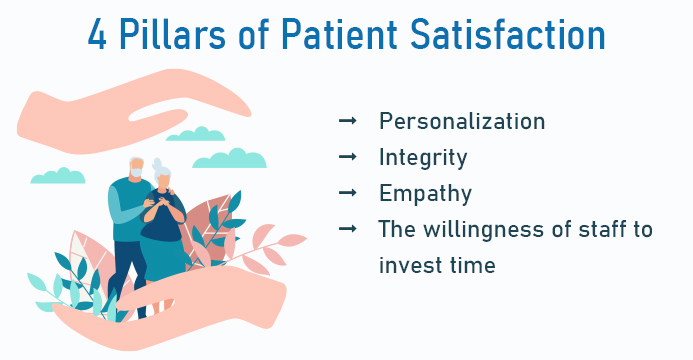
A satisfied patient is your best healthcare marketing strategy. Period.
If you’re a regular reader of Practice Builders’ blog, you must have noticed that we emphasize the importance of patient satisfaction and a seamless, personalized patient experience across all touch points.
Zeroing in on patient satisfaction and experience has several benefits. According to recent research, healthcare practices that keep their patients satisfied and successfully manage customer experience strategies reap enormous rewards: increased revenue, reduced turnover, stronger patient-provider relationships, and better word-of-mouth marketing.
But how do you keep your patients satisfied?
Although patient experience and satisfaction are not precisely the same, they are very closely related.
Patient experience is how a patient perceives your brand while interacting with it throughout his or her wellness journey.


On the other hand, patient satisfaction is a metric that measures how happy patients are with your services and capabilities. It reflects how a patient feels when interacting with your staff: poor patient satisfaction may lead to negative online reviews, while satisfied patients will help you build your brand.
Related Blog: 25 Ways to Measure Patient Satisfaction
Who is a satisfied patient?
A satisfied patient is someone who thinks your medical practice is effective in delivering its services. When asked, satisfied patients will likely say good things about your services, staff, or brand.
The goal of every medical practice is to nurture satisfied patients, turning them into brand advocates. However, to keep patients truly satisfied, it’s not enough to avoid upsetting them. You have to understand your target audience, improve your care quality, and upgrade your technology to create an experience they would want to turn to consistently.

What are the key factors that influence patient satisfaction?
Factors Influencing Patient Satisfaction
According to patient experience and satisfaction experts at Practice Builders, the four pillars of patient satisfaction include personalization, integrity, empathy, and the willingness of your staff to invest time and efforts in patients’ wellness.
By tapping into these factors, you can provide consistent patient experiences resulting in satisfied patients.
1. Providing personalized communication
The majority of patients prefer to visit a healthcare practice that delivers a personalized experience. One of the best ways to offer a personalized experience is using the patient’s name when talking with them – in person, through email, and over the phone. A friendlier approach will help humanize the patient-provider relationship. In addition to addressing patients by their first names, consider sending personalized emails to them when they schedule appointments, visit your practice, or send an inquiry. Even if most patients don’t take up your offer of help, they will appreciate the gesture and form a positive impression of your medical practice.


2. Offering omnichannel support
How easy is it for your patients to contact you? One of the most common complaints patients have is that getting in touch with their providers – particularly in real-time – is a challenge. If you are wondering what omnichannel support is, it means having a presence in place on every possible channel where your patients are active. Patients these days use multiple channels and devices to stay connected to their providers. It’s more convenient and easy for them, and your patient support strategy must consider all of that. When patients have an urgent question for you, they expect a quick response. Think about it – most people usually do not have a lot of free time. So, spending even half an hour dealing with your front desk staff can seriously harm patient satisfaction levels.
3. Tracking patients’ feedback
Listening to your patients, both satisfied and unsatisfied, and figuring out what is working for them and what difficulties are standing in the way of an excellent patient experience will go a long way in ensuring patient satisfaction. Conduct frequent patient satisfaction surveys and go through each response to see which areas need improvement and how you can fix the gaps. Just remember, conducting patient surveys but not acting on feedback will not make them satisfied. Make sure to really focus on patient feedback to help improve the experience and satisfaction levels. Also, don’t just wait for patients to leave feedback. Train your staff to be proactive and ask patients for feedback whenever there’s an opportunity. Consider sending surveys to patients after the appointment to find how satisfied they were with your services.
Related Blog: 6 Patient Satisfaction Survey Mistakes You Must Avoid
4. Training your employees
The key to handling dissatisfied patients is to make them feel important. Sometimes employees handling an angry patient can make him or her feel valued and solve the problem. Other times, your staff can only handle a situation by escalating the issue to a senior employee. Whichever way your staff decides to handle a disgruntled patient, train them to solve the problem with grace and not offend the patient further. Always encourage your staff to perform well and go the extra mile in ensuring the patient is satisfied. If the issues in patient satisfaction are related to your staff’s attitude rather than service quality, it could be valuable to look at which specific instances are causing problems. If it’s something like extended wait timings or phone calls going unanswered, you can resolve the problem by scaling your team or providing better time management training.
Related Blog: Improve Patient Satisfaction Through Efficient Call Handling

Conclusion
In the battle to maximizing patient satisfaction, the goal is more than a referral or a repeat appointment. The prize at stake is patient loyalty.
A satisfied patient can and will help you convert leads into patients, but brand advocates can be much more powerful in the digital age. An exceptional patient experience creates the kind of satisfied patients who will choose your services and encourage their friends and family to do the same.
Third-party review sites like Healthgrades and Vitals empower patients to share their stories and impact the thoughts of potential patients.
Ask yourself. How likely are you to choose a medical practice with only one star on Healthgrades?
If you find yourself incapable of perfecting each aspect of patient satisfaction, don’t stress over it. Many medical practices don’t have the time, resources, or knowledge to build and increase patient satisfaction. This is where we come into the picture.
Get in touch with us to understand how our proven services and decades of experience can help you transform your patients’ experience and significantly increase patient satisfaction.
[adsanity align=’alignnone’ id=20686]
Looking For Healthcare Marketing Agency For Hospitals , Clinics, Doctors?
Call Pursho @ 0731-6725516







